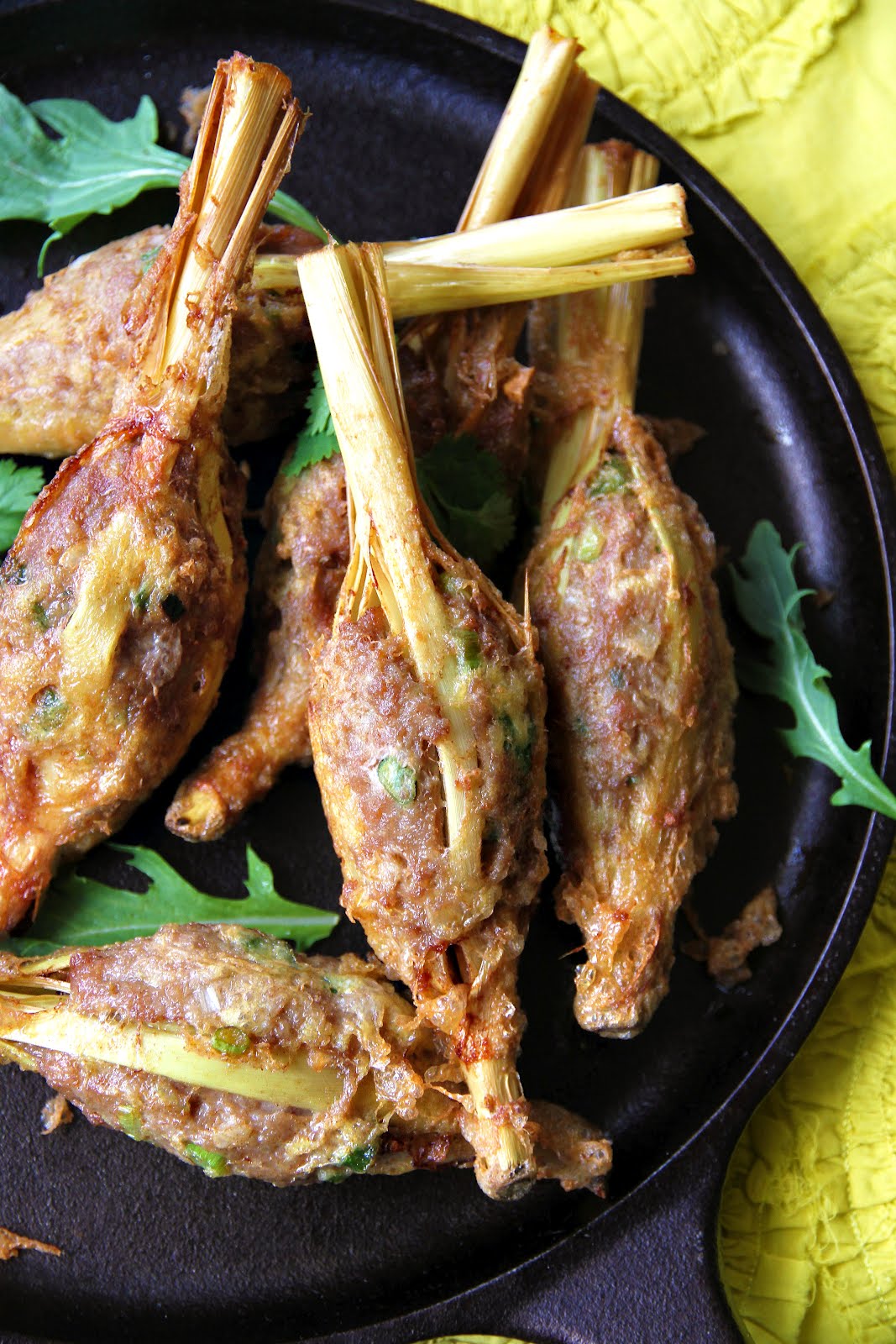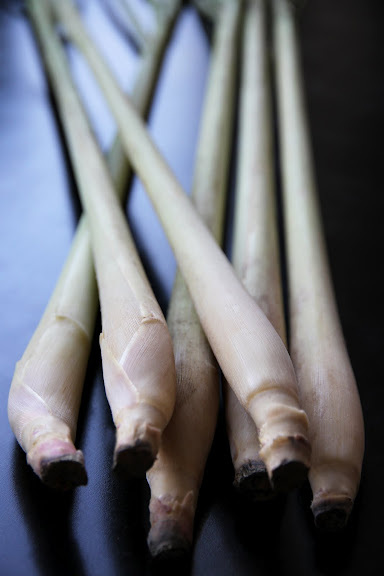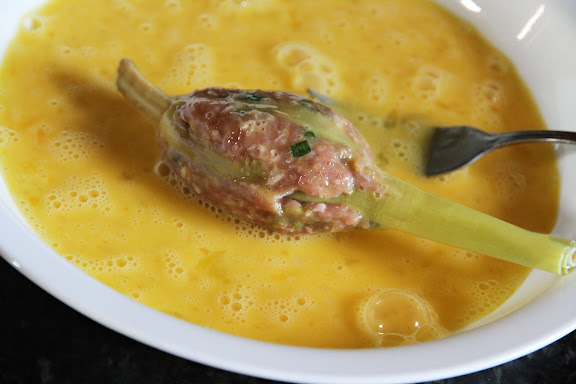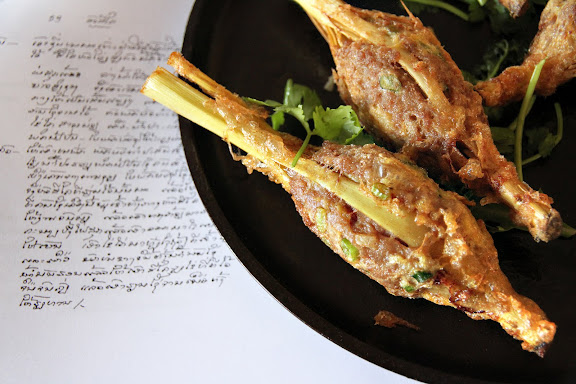
Sweet. (Easier to understand. After all, me no speak English so good.)
With the Thai version of the book in my possession, I’ve been making Phia Sing’s recipes for a few weeks now. And so far, Ua Si Khai (Oo-ah See Kye), literally stuffed lemongrass, is one of my favorites. It was also the first recipe I tried out.

Phia Sing’s recipes seem to have been written with the assumption that the end users have already been familiar with the basics of Lao cooking. But I wouldn’t let that be a problem. For one thing, though the equipments and terminology employed in various cuisines may be different, the physics of cooking is universal and cooking itself is instinctive. Besides, the lack of precision or clarity can be viewed as an invitation to improvise and adjust things to suit one’s taste. The ultra-traditional, almost to the point of being archaic, cooking methods employed in the recipe also require some creative solutions in a modern kitchen.
And that’s exactly what I did.

For example, Phia Sing’s recipe calls for “a piece of pork the size of your palm” which is to be chopped up finely (meaning you need to do this on a chopping block with a large cleaver); I just use ground pork from the supermarket. The recipe tells you to mash up some shallots in a mortar and mix them into the meat; I replace the shallots with finely-chopped green onions and add a few cloves of garlic which is an ingredient not found in the original recipe. The recipe also tells you to cook lemongrass stalks in ashy coals until pliable enough to manipulate; I steam them in a microwave. The recipe instructs you to make several fine cuts on the lemongrass stalks with a needle; I make only 6-7 cuts with the tip of my paring knife. Lastly, the recipe specifies that the stuffed lemongrass stalks be wrapped in banana leaves, grilled over coals, and cooled before you deep-fry them; I skip this step entirely.
I took the easy way out not out of disrespect but necessity. Forgive me. But if my wayward ways appeal to you, feel free to do what this baddie has done.

I love that Phia Sing’s Ua Si Khai recipe is seasoned very, very simply. There are no strong herbs such as kaffir lime leaves, basil, or mint involved. This allows the assertive-but-not-at-all-aggressive scent of the lemongrass to come through loud and clear. After all, isn’t this the whole idea behind the dish?
This is also the reason why I don’t feel compelled to serve it with any strong-flavored dipping sauce. Ua Si Khai needs no further adornment.

Lao Stuffed Lemongrass (Ua Si Khai)
Adapted from the recipe by Phia Sing [1]
- 6 stalks of lemongrass, trimmed to six inches in length (measuring from the bottom)
- ⅓ lb ground pork (ground chicken or ground turkey will do too)
- 2 green onions, finely chopped
- 3 large cloves garlic, peeled and finely chopped
- 2 teaspoons cornstarch
- 1 tablespoon fish sauce
- ½ teaspoon salt
- 1 teaspoon ground white pepper
- 2 large eggs, slightly beaten
- Vegetable oil for deep-frying
- Wrap the lemongrass stalks loosely with a piece of paper towel and microwave on high for 4 minutes or less. You want them to be justsoft enough to be pliable while still retaining as much of their fragrant essential oil as possible.
- With the tip of a sharp paring knife, make several 4-inch cuts lengthwise all around the lemongrass stalks, starting about ½ inch from the bottom. By doing this, you’re turning each stalk of lemongrass into a basket — a cage, if you will — which will hold the meat. So it’s imperative that you leave both ends of the lemongrass stalks intact.
- In a mixing bowl, mix together all ingredients, except the eggs and the frying oil. Divide the mixture into six portions.
- Stuff one portion of the meat into each lemongrass “cage.” Try to get the meat to stay inside the cage as best as you can, but if some oozes out, it’s not the end of the world.
- Once you’ve filled the lemongrass stalks with all the meat, press each filled stalk with your palms (easier if your hands are moistened) to form a tight rugby ball-shaped capsule.
- Heat up the frying oil until it reaches about 300°F. (We don’t want the temperature to get too high as the outsides of the filled lemongrass stalks will burn before they’re cooked all the way through.)
- Dip each filled lemongrass stalk into the beaten eggs, making sure it’s thoroughly coated, and drop it into the hot oil slowly and carefully.
- Once the filled lemongrass stalks turn golden brown, give each one a light squeeze with a pair of tongs. If the inside is cooked all the way through, you should feel some resistance.
- Transfer your Ua Si Khai from the oil and let them cool on a paper towel-lined plate.
- Serve with steamed jasmine rice or sticky rice.
[1] ตำรับพระราชวังหลวงพระบาง (“Recipes from the Palace of Luang Prabang”), p. 211, Butterfly Book House, Bangkok: 2010, translated into Thai by Pensri Thongyai Na Ayudhaya and Jinda Chamroen from Traditional Recipes of Laos by Phia Sing.








15 Responses to Lao Stuffed Lemongrass (Ua Si Khai)